Effect of Karst Geomorphology on the Sedimentary Mineralization and Geochemical Distribution of Bauxite: An Example from the Xiaoyuan Area in Qingzhen, Guizhou Province
Abstract
:1. Introduction
2. Geological Setting
2.1. Regional Geology
2.2. Deposit Geology
3. Sampling and Analytical Methods
3.1. Controlled-Source Audio-Frequency Magnetotellurics
3.2. Geological Modeling
3.3. Analysis of the Major Elements
3.4. Analysis of Trace Elements
3.5. XRD
3.6. Mineralogical Analysis
4. Results
4.1. Inversion Map of Apparent Resistivity
4.2. Geological Model
4.3. Geological Characteristics and Distribution of Bauxite Deposits in the Study Area
4.4. Results of the Mineralogical Analysis of Karst Geomorphology
4.5. Geochemical Characteristics of the Karst Geomorphology
4.5.1. Geochemical Characteristics of the Major Elements
4.5.2. Geochemical Characteristics of the Trace Elements
5. Discussion
5.1. Effect of the Karst Geomorphology on Mineral Facies
5.2. Effect of Karst Geomorphology on the Element Distribution
5.2.1. Horizontal Element Distribution
5.2.2. Vertical Element Distribution

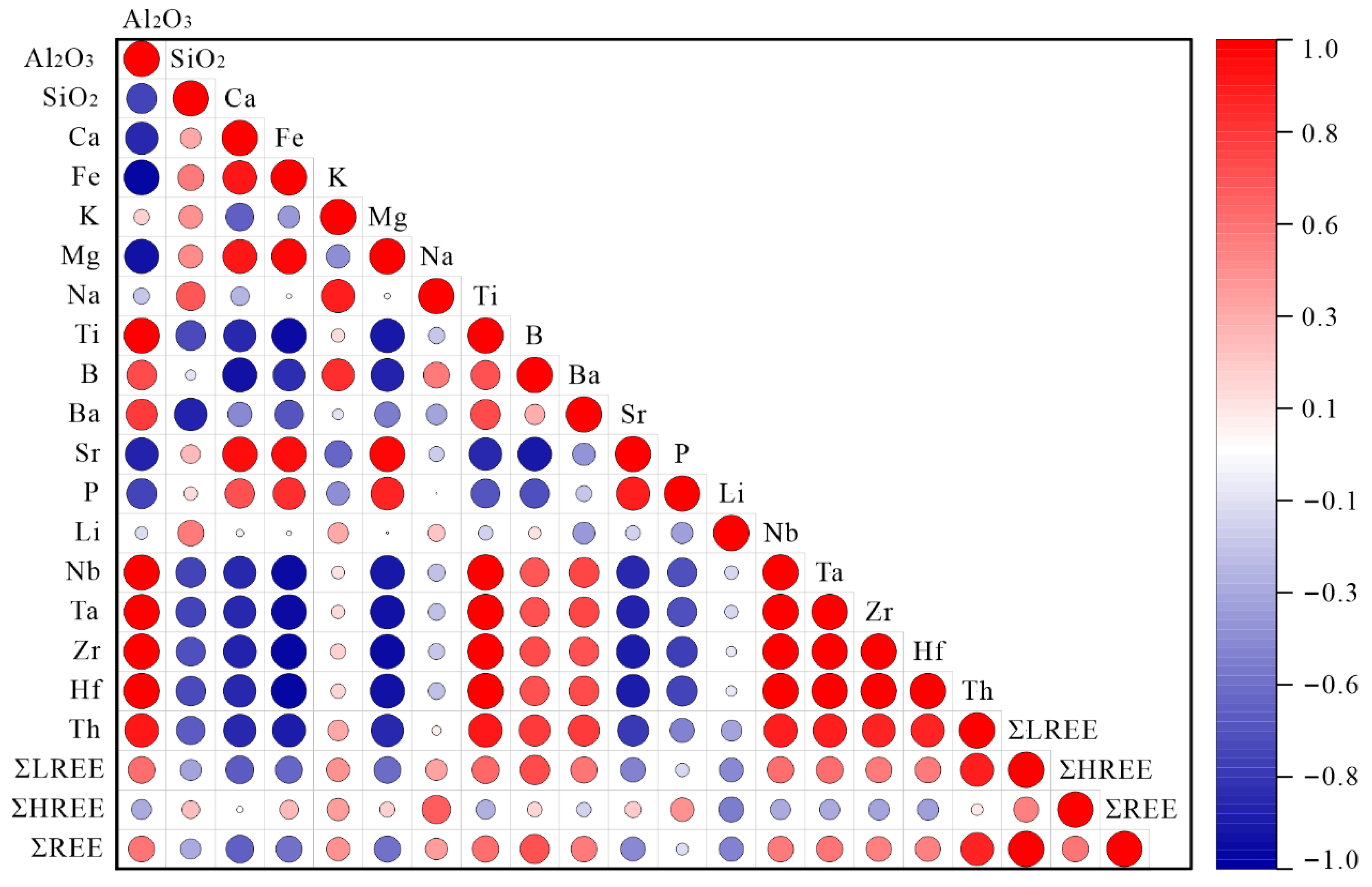
5.3. Ore-Forming Process of Bauxite

6. Conclusions
- (1)
- Controlled-source audio-frequency magnetotellurics was employed to infer the topography of the study area and convert it into coordinate data. The coordinates were adjusted using stratigraphic information obtained from drilling data. Geological modeling was conducted to reconstruct the paleokarst landform characteristics of the bauxite deposits in the Xiaoyuan area.
- (2)
- The distribution of bauxite was influenced by ancient landforms. Horizontally, the bauxite grade was higher at the core of the karst depressions and lower in the surrounding area. The TiO2 and SiO2 contents had strong positive and negative correlations with the Al2O3 content, respectively. The Fe2O3 content was higher near the source area and lower farther away. Vertically, the bauxite in high-elevation regions showed a high iron content and low aluminum content, with a mineral assemblage comprising diaspore, siderite, anatase, and chlorite. Bauxite in low-elevation areas exhibited a lower iron content and a higher aluminum content, accompanied by a mineral assemblage consisting of diaspore, pyrite, illite, and anatase.
- (3)
- Karst bauxite mineralization models for high-iron, low-aluminum contents and low-iron, high-aluminum contents were established. The former occurred in continental environments where the bauxite material rapidly accumulated in karst depressions at higher elevations. The latter was formed through modifications caused by seawater after the initial bauxite materials underwent sedimentation; this process typically occurred at lower elevations.
Supplementary Materials
Author Contributions
Funding
Data Availability Statement
Conflicts of Interest
References
- Gao, D.D.; Sheng, Z.Q.; Shi, S.H.; Chen, L.A. Studies on the Bauxite Deposit in Central Guizhou; Guizhou Science and Technology Publishing House: Guizhou, China, 1992; pp. 1–152. (In Chinese) [Google Scholar]
- Ling, K.Y.; Zhu, X.Q.; Tang, H.S.; Wang, Z.G.; Yan, H.W.; Han, T.; Chen, W.Y. Mineralogical characteristics of the karstic bauxite deposits in the Xiuwen ore belt, Central Guizhou Province, Southwest China. Ore Geol. Rev. 2015, 65, 84–96. [Google Scholar] [CrossRef]
- Long, Y.Z.; Chi, G.X.; Liu, J.P.; Jin, Z.G.; Dai, T.G. Trace and rare earth elements constraints in the sources of the Y unfeng paleo-karstic bauxite deposit in the Xiuwen-Qingzhen area, Guizhou, China. Ore Geol. Rev. 2017, 91, 404–418. [Google Scholar] [CrossRef]
- Luo, C.K.; Yang, R.D.; Gao, J.B.; Muhammad, U.M.A.I.R.; Wang, L.B.; Gao, L. Viséan fossil plants from the Jiujialu Formation in central Guizhou Province: Implications for age of bauxite and palaeoenvironment. Acta Geol. Sin.-Engl. Ed. 2020, 94, 2165–2177. [Google Scholar] [CrossRef]
- Luo, C.K.; Liang, P.; Yang, R.D.; Gao, J.B.; Chen, Q.; Mo, H.C. Mineralogical and Geochemical Constraints on the Occurrence Forms of REEs in Carboniferous Karst Bauxite, Central Guizhou Province, Southwest China: A Case Study of Lindai Bauxite. Minerals 2023, 13, 320. [Google Scholar] [CrossRef]
- Wang, Q.F.; Deng, J.; Liu, X.F.; Zhang, Q.Z.; Li, Z.M.; Kang, W.; Cai, S.H.; Li, N. Review on research of bauxite geology and genesis in China. Geol. Explor. 2012, 48, 430–448. [Google Scholar]
- Bárdossy, G. Karst Bauxites: Bauxite Deposits on Carbonate Rocks; Elsevier: Amsterdam, The Netherlands, 1982. [Google Scholar]
- Yu, W.; Algeo, T.J.; Y an, J.; Y ang, J.; Du, Y.; Huang, X.; Weng, S. Climatic and hydrologic controls on upper Paleozoic bauxite deposits in South China. Earth-Sci. Rev. 2018, in press. [Google Scholar] [CrossRef]
- Li, P.G.; Yu, W.C.; Du, Y.S.; Lai, X.L.; Weng, S.F.; Pang, D.W.; Xiong, G.L.; Lei, Z.Y.; Zhao, S.; Yang, S.Q. Influence of geomorphology and leaching on the formation of Permian bauxite in northern Guizhou Province, South China. J. Geochem. Explor. 2020, 210, 106446. [Google Scholar] [CrossRef]
- Wang, Q.F.; Liu, X.F.; Yang, S.J.; Zhang, Q.Z.; Deng, J. How is karst type bauxite formed? Earth Sci. 2022, 47, 3880–3881. (In Chinese) [Google Scholar]
- D’Argenio, B.; Mindszenty, A. Bauxites and related paleokarst: Tectonic and climatic event markers at regional unconformities. Eclogae Geol. Helv. 1995, 88, 453–499. [Google Scholar]
- Cheng, P.L.; Li, S.N.; Chen, Q.; Wu, X.H. The genesis of the bauxite deposit in central Guizhou is discussed based on the output characteristics of high iron bauxite in Maochang mining area of Qingzhen. Guizhou Geol. 2004, 4, 215–222. (In Chinese) [Google Scholar]
- Valeton, I. Saprolite-Bauxite Facies of Ferralitic Duricrusts on Palaeosurfaces of Former Pangaea, Palaeoweathering, Palaeosurfaces and Related Continental Deposits; Blackwell Publishing Ltd.: Hoboken, NJ, USA, 2009; pp. 153–188. [Google Scholar]
- Liu, P.; Han, Z.H.; Nie, K. Characteristics of ore-bearing rock series, control conditions and generative development model of karst bauxite deposit in central Guizhou—southern Chongqing. Geol. Rev. 2022, 68, 11. [Google Scholar] [CrossRef]
- Wang, R.X.; Wang, Q.F.; Huang, Y.X.; Yang, S.J.; Liu, X.F.; Zhou, Q. Combined tectonic and paleogeographic controls on the genesis of bauxite in the early Carboniferous to Permian Central Yangtze Island. Ore Geol. Rev. 2018, 101, 468–480. [Google Scholar] [CrossRef]
- Luo, C.K.; Yang, R.D.; Chen, J.; Gao, L.; Xu, H.; Ni, X.R. Genesis of the Carboniferous karstic bauxites in Qingzhen region, central Guizhou, southwest China. J. Geochem. Explor. 2022, 235, 106955. [Google Scholar] [CrossRef]
- Deng, X.; Yang, K.G.; Liu, Y.L.; She, Z.B. Characteristics and tectonic evolution of Qianzhong Uplift. In Earth Science Frontiers; China University of Geosciences (Beijing); Peking University: Beijing, China, 2010; Volume 13, pp. 79–89. (In Chinese) [Google Scholar]
- Liu, W.; Xu, X.S.; Yu, Q. Discussion on forming mechanism and evolution of the central Guizhou Palaeouplift. Acta Sedimentol. Sin. 2011, 29, 658–664, (In Chinese with English Abstract). [Google Scholar]
- Tang, L.J.; Guo, T.L.; Tian, H.Q.; Jin, W.Z.; Li, R.F.; Wan, G.M.; Dong, L.; Wang, P.W. Poly-cycle tectonic evolution, differential deformation and hydrocarbon reservation of Central Guizhou and adjacent region. Acta Geol. Sin. 2008, 82, 298–307, (In Chinese with English Abstract). [Google Scholar]
- GBGM (Guizhou Bureau of Geology and Minerals). Geological Marks of Guizhou Province; Geological Publishing House: Beijing, China, 1987; pp. 1–360. (In Chinese) [Google Scholar]
- Gan, T.; Luo, T.Y.; Pang, K.; Zhou, C.M.; Zhou, G.H.; Wan, B.; Li, G.; Yi, Q.R.; Czaja, A.D.; Xiao, S.H. Cryptic terrestrial fungus-like fossils of the early Ediacaran Period. Nat. Commun. 2021, 12, 641. [Google Scholar] [CrossRef]
- Liao, Q.T. Characteristics and application range of V8 multifunctional electrical measurement system. Resour. Environ. Eng. 2008, 22, 150–153. (In Chinese) [Google Scholar] [CrossRef]
- Yan, W.H.; Liu, Y.F.; You, L.Q. The application of comprehensive geophysical prospecting method to exploring a certain zinc and lead deposit in northwest Guizhou Province. Geophys. Geochem. Explor. 2016, 40, 688–694. [Google Scholar] [CrossRef]
- Jin, R.G.; Zhang, J.H.; Wang, Q.S. Research on the method and technology of magneticprospecting method using V8 systems. China Min. Mag. 2016, 25, 146–149. [Google Scholar]
- Wang, L. AMT Forwarding Modeling and Inversion Algorithms and Software Development; Central South University: Changsha, China, 2013. [Google Scholar]
- Zhao, G.Z.; Liu, G.D. An inversion method on two-dimensional magnetotelluric model. Seismol. Geol. 1985, 7, 56–58. [Google Scholar]
- Deng, X.S.; Du, Y.S.; Yu, W.C.; Wu, K.B.; Lu, S.F.; Zhang, H.B. Qianzhong Uplift’and evolution of the Late Paleozoic palaeogeography and its control on formation of bauxite in Guizhou Province. J. Palaeogeogr. (Chin. Ed.) 2020, 22, 5. [Google Scholar]
- Saad, R.; Nawawi, M.N.M.; Mohamad, E.T. Groundwater detection in alluvium using 2-D electrical resistivity tomography (ERT). Electron. J. Geotech. Eng. 2012, 17, 369–376. [Google Scholar]
- Wang, X.B. Application Study of High-Density Resistivity Imaging Method in the Quaternary Lithology of Juye River Basin; Shandong Agricultural University: Tai’an, China, 2020. [Google Scholar] [CrossRef]
- Zhang, Z.W.; Zhou, L.J.; Li, Y.J.; Wu, C.Q.; Zheng, C.F. The “coal-bauxite-iron” structure in the ore-bearing rock series as a prospecting indicator for southeastern Guizhou bauxite mines. Ore Geol. Rev. 2013, 53, 145–158. [Google Scholar] [CrossRef]
- Yang, R.D.; Gao, J.B.; Zhao, K.; Yu, J.L.; Zhu, C.L.; Gao, L.; Chen, J.Y.; Zhou, R.X. Roof and Floor Characteristics of Bauxite in Qingzhen, Guizhou and Its Implication for Bauxite Mineralization. Acta Geol. Sinca 2018, 92, 2155–2165, (In Chinese with English Abstract). [Google Scholar]
- Ahmadnejad, F.; Zamanian, H.; Taghipour, B.; Zarasvandi, A.; Buccione, R.; Ellahi, S.S. Mineralogical and geochemical evolution of the Bidgol bauxite deposit, Zagros Mountain Belt, Iran: Implications for ore genesis, rare earth elements fractionation and parental affinity. Ore Geol. Rev. 2017, 86, 755–783. [Google Scholar] [CrossRef]
- Liu, X.F.; Wang, Q.F.; Feng, Y.W.; Li, Z.M.; Cai, S.H. Genesis of the Guangou karstic bauxite deposit in western Henan, China. Ore Geol. Rev. 2013, 55, 162–175. [Google Scholar] [CrossRef]
- Liu, X.F.; Wang, Q.F.; Zhao, L.H.; Peng, Y.B.; Ma, Y.; Zhou, Z.H. Metallogeny of the large-scale Carboniferous karstic bauxite in the Sanmenxia area, southern part of the North China Craton, China. Chem. Geol. 2020, 556, 119851. [Google Scholar] [CrossRef]
- Zhang, L.; Park, C.; Wang, G.H.; Wu, C.J.; Santosh, M.; Chung, D.; Song, Y. Phase transformation processes in karst-type bauxite deposit from Yunnan area, China. Ore Geol. Rev. 2017, 89, 407–420. [Google Scholar] [CrossRef]
- Yang, S.J.; Huang, Y.X.; Wang, Q.F.; Deng, J.; Liu, X.F.; Wang, J.Q. Mineralogical and geochemical features of karst bauxites from Poci (western Henan, China), implications for parental affinity and bauxitization. Ore Geol. Rev. 2019, 105, 295–309. [Google Scholar] [CrossRef]
- Zhang, J.Y.; Wang, Q.F.; Liu, X.F.; Zhou, G.F.; Xu, H.P.; Zhu, Y.G. Provenance and ore-forming process of Permian lithium-rich bauxite in central Yunnan, SW China. Ore Geol. Rev. 2022, 145, 104862. [Google Scholar] [CrossRef]
- Liu, X.F.; Wang, Q.F.; Zhang, Q.Z.; Yang, S.J.; Liang, Y.Y.; Zhang, Y.; Li, Y.; Guan, T. Genesis of the Permian karstic Pingguo bauxite deposit, western Guangxi, China. Miner. Depos. 2017, 52, 1031–1048. [Google Scholar] [CrossRef]
- Wang, R.X.; Wang, Q.F.; Uysal, I.T.; Ramanaidou, E.; Deng, J.; Todd, A. Mesozoic hydrothermal overprint on carboniferous bauxite in China. Econ. Geol. 2021, 116, 787–800. [Google Scholar] [CrossRef]
- Wang, R.X. Mineral Compositions and Metallogenic Mechanism of Important Bauxite Concentration Areas in China; China University of Geosciences Beijing: Beijing, China, 2019. [Google Scholar]
- Xing, B.B.; Graham, N.; Yu, W.Z. Transformation of siderite to goethite by humic acid in the natural environment. Commun. Chem. 2020, 3, 38. [Google Scholar] [CrossRef] [PubMed] [Green Version]
- Zamanian, H.; Ahmadnejad, F.; Zaravandi, A. Mineralogical and geochemical investigations of the Mombi bauxite deposit, Zagros Mountains, Iran. Chem. Der Erde 2016, 73, 13–37. [Google Scholar] [CrossRef]
- Ling, K.Y.; Zhu, X.Q.; Tang, H.S.; Li, S.X. Importance of hydrogeological conditions during formation of the karstic bauxite deposits, Central Guizhou Province, Southwest China: A case study at Lindai deposit. Ore Geol. Rev. 2017, 82, 198–216. [Google Scholar] [CrossRef]
- Sun, J.H.; Chen, Q.Y. Mineral composition of bauxite in central Guizhou province. Sci. Geol. Sin. 1992, 226–237. [Google Scholar]
- Bárdossy, G.; Aleva, G.J.J. Lateritic Bauxites; Elsevier Scientific Publication: Amsterdam, The Netherlands, 1990; pp. 1–624. [Google Scholar]
- Wang, E.F. The origin of red high iron bauxite in some mining areas in Paleozoic. Light Met. 1982, 9, 1–6. (In Chinese) [Google Scholar]
- Liu, P.; Liao, Y.C. The zonation and genetic mechanism of Zunyi high-and low-ferrous bauxites. Geol. China 2013, 40, 949–966. [Google Scholar]
- Ling, K.Y.; Wen, H.J.; Fan, H.F.; Zhu, X.K.; Li, Z.H.; Zhang, Z.W.; Stephen, E.G. Iron loss during continental weathering in the early Carboniferous period recorded by karst bauxites. J. Geophys. Res. Earth Surf. 2023, 128, e2022JF006906. [Google Scholar] [CrossRef]
- Vincent, G.; Vincent, O.; Olivier, B.; Cécile, M.; Esmaeil, S.; Jules, F.; Lucilla, B.; Valéry, G. Weathering-limited hillslope evolution in carbonate landscapes. Earth Planet. Sci. Lett. 2016, 446, 10–20, ISSN 0012-821X. [Google Scholar] [CrossRef] [Green Version]
- Laskou, M.; Economou-Eliopoulos, M. The role of microorganisms on the mineralogical and geochemical characteristics of the Parnassos-Ghiona bauxite deposits, Greece. J. Geochem. Explor. 2007, 93, 67–77. [Google Scholar] [CrossRef]
- Liu, X.F.; Wang, Q.F.; Deng, J.; Zhang, Q.Z.; Sun, S.L.; Meng, J.Y. Mineralogical and geochemical investigations of the Dajia Salento-type bauxite deposits, western Guangxi, China. J. Geochem. Explor. 2010, 105, 137–152. [Google Scholar] [CrossRef]
- Jin, Z.G.; Liu, C.S.; Zhou, L.; Zheng, M.H.; Zhang, L.; Han, Y. Geochemical evidence of sedimentary environment of permian bauxite in the Wuchuan-Zheng’an-Daozhen area, Guizhou province. Acta Geol. Sin. 2018, 92, 817–827. [Google Scholar]
- Abedini, A.; Khosravi, M. Geochemical constraints on the Triassic–Jurassic Amir-Abad karst-type bauxite deposit, NW Iran. J. Geochem. Explor. 2020, 211, 106489. [Google Scholar] [CrossRef]
- Abedini, A.; Mongelli, G.; Khosravi, M.; Sinisi, R. Geochemistry and secular trends in the middle–late Permian karst bauxite deposits, northwestern Iran. Ore Geol. Rev. 2020, 124, 103660. [Google Scholar] [CrossRef]
- Abedini, A.; Mongelli, G.; Khosravi, M. Geochemical constraints on the middle Triassic Kani Zarrineh karst bauxite deposit, Irano–Himalayan belt, NW Iran: Implications for elemental fractionation and parental affinity. Ore Geol. Rev. 2021, 133, 104099. [Google Scholar] [CrossRef]
- Liu, Y.J.; Cao, L.M.; Li, Z.L.; Wang, H.N.; Chu, T.Q.; Zhang, Y.R. Geochemistry of the Elements; Science Press: Beijing, China, 1986; pp. 1–386. (In Chinese) [Google Scholar]
- Nesbitt, H.W. Mobility and fractionation of rare earth elements during weathering of a granodiorite. Nature 1979, 279, 206–210. [Google Scholar] [CrossRef]
- Duddy, L.R. Redistribution and fractionation of rare-earth and other elements in a weathering profile. Chem. Geol. 1980, 30, 363–381. [Google Scholar] [CrossRef]
- Ji, H.B.; Wang, S.J.; Ouyang, Z.Y.; Zhang, S.; Sun, C.X.; Liu, X.M.; Zhou, D.Q. Geochemistry of red residua underlying dolomites in karst terrains of Yunnan-Guizhou Plateau II. The mobility of rare earth elements during weathering. Chem. Geol. 2004, 203, 29–50. [Google Scholar] [CrossRef]
- Mongelli, G. Ce-anomalies in the textural components of Upper Cretaceous karst bauxites from the Apulian carbonate platform (southern Italy). Chem. Geol. 1997, 140, 69–79. [Google Scholar] [CrossRef]
- Khosravi, M.; Abedini, A.; Alipour, S.; Mongelli, G. The Darzi-Vali bauxite deposit, West-Azarbaidjan Province, Iran: Critical metals distribution and parental affinities. J. Afr. Earth Sci. 2017, 129, 960–972. [Google Scholar] [CrossRef]
- Abedini, A.; Mongelli, G.; Khosravi, M. Geochemistry of the early Jurassic Soleiman Kandi karst bauxite deposit, Irano–Himalayan belt, NW Iran: Constraints on bauxite genesis and the distribution of critical raw materials. J. Geochem. Explor. 2022, 241, 107056. [Google Scholar] [CrossRef]
- Meshram, R.R.; Randive, K.R. Geochemical study of laterites of the Jamnagar district, Gujarat, India: Implications on parent rock, mineralogy and tectonics. J. Asian Earth Sci. 2011, 42, 1271–1287. [Google Scholar] [CrossRef]
- Braun, J.J.; Pagel, M.; Herbilln, A.; Rosin, C. Mobilization and redistribution of REEs and thorium in a syenitic lateritic profile: A mass balance study. Geochim. Et Cosmochim. Acta 1993, 57, 4419–4434. [Google Scholar] [CrossRef]
- Mameli, P.; Mongelli, G.; Oggiano, G.; Dinelli, E. Geological, geochemical and mineralogical features of some bauxite deposits from Nurra (Western Sardinia, Italy): Insights on conditions of formation and parental affinity. Int. J. Earth Sci. 2007, 96, 887–902. [Google Scholar] [CrossRef]
- Wang, T.S.; Fu, Y.; Chen, P.W.; Hou, K.J.; Tang, B.; Luo, P.Q.; Yao, L.; Liu, B.; Long, Z.; Liu, Y.; et al. Detrital composition and sedimentary provenance of Early Carboniferous Al-bearing rock series in central Guizhou. Ore Geol. Rev. 2023, 156, 105404. [Google Scholar] [CrossRef]
- Franceschelli, M.; Puxeddu, M.; Memmi, I. Li, B-rich Rhaetian metabauxite, Tuscany, Italy: Reworking of older bauxites and igneous rocks. Chem. Geol. 1998, 144, 221–242. [Google Scholar] [CrossRef]
- Wang, Q.F.; Liu, X.F.; Yan, C.H.; Cai, S.H.; Li, Z.M.; Wang, Y.R.; Zhao, J.M.; Li, G.J. Mineralogical and geochemical studies of boron-rich bauxite ore deposits in the Songqi region, SW Henan, China. Ore Geol. Rev. 2012, 48, 258–270. [Google Scholar] [CrossRef]
- De Bussetti, S.G.; Ferreiro, E.A.; Helmy, A.K. Sorption of Boron by Hydrous Al-Oxide. Clays Clay Min. 1995, 43, 58–62. [Google Scholar] [CrossRef]
- Xiao, R.G.; Takao, O.; Cai, K.Q.; Yoshikazu, K. Application of boron and boron isotopic geochemistry in the study of geological process. In Earth Science Frontiers; China University of Geosciences: Beijing, China, 1999; Volume 2, pp. 168–175. [Google Scholar]
- Wang, X.J.; Wang, Z.T.; Wang, G.H.; Zhou, J.; Cui, Y.L.; Zhang, D.H. Geochemical characteristics and ore-forming environment of the Songgui bauxite deposit in Heqing county, Northwest Yunnan province. Northwestern Geol. 2017, 50, 205–221. [Google Scholar]
- Yu, W.C.; Du, Y.S.; Gu, S.Z.; Cui, T.; Huang, X.; Yu, J.X.; Qin, Y.J.; Lei, Z.Y.; Weng, S.F.; Cao, J.Z. Multiperiod leaching process of early Permian bauxitein Wuchuan-Zheng’an-Daozhen area, northern Guizhou province and its significance of ore control. Geol. Sci. Technol. Inf. 2013, 32, 34–39. [Google Scholar]
- Barrat, J.A.; Taylor, R.N.; André, J.P.; Nesbitt, R.W.; Lecuyer, C. Strontium isotopes in biogenic phosphates from a neogene marine formation: Implications for palaeoseawater studies. Chem. Geol. 2000, 168, 325–332, ISSN 0009-2541. [Google Scholar] [CrossRef]
- Feng, X.L.; Long, J.Z. A genetic model for the Maochang bauxite depositin in central Guizhou. Guizhou Geol. 1997, 14, 285–298. [Google Scholar]
- Sun, S.S.; McDonough, W.F. Chemical and isotopic systematics of oceanic basalts: Implications for mantle composition and processes. Geol. Soc. Lond. Spec. Publ. 1989, 42, 313–345. [Google Scholar] [CrossRef]
- Yin, Z.M. The Texture and Structure features of Carboniferous Bauxite in China and Its Emplacement Mechanism. J. Cent. South Univ. Min. Metall. 1988, 19, 357–363. [Google Scholar]
- Yu, W.C.; Wang, R.H.; Zhang, Q.L.; Du, Y.S.; Chen, Y.; Liang, Y.P. Mineralogical and geochemical evolution of the fusui bauxite deposit in Guangxi, south China: From the original Permian orebody to a Quarternary salento-type deposit. J. Geochem. Explor. 2014, 146, 75–88. [Google Scholar] [CrossRef]
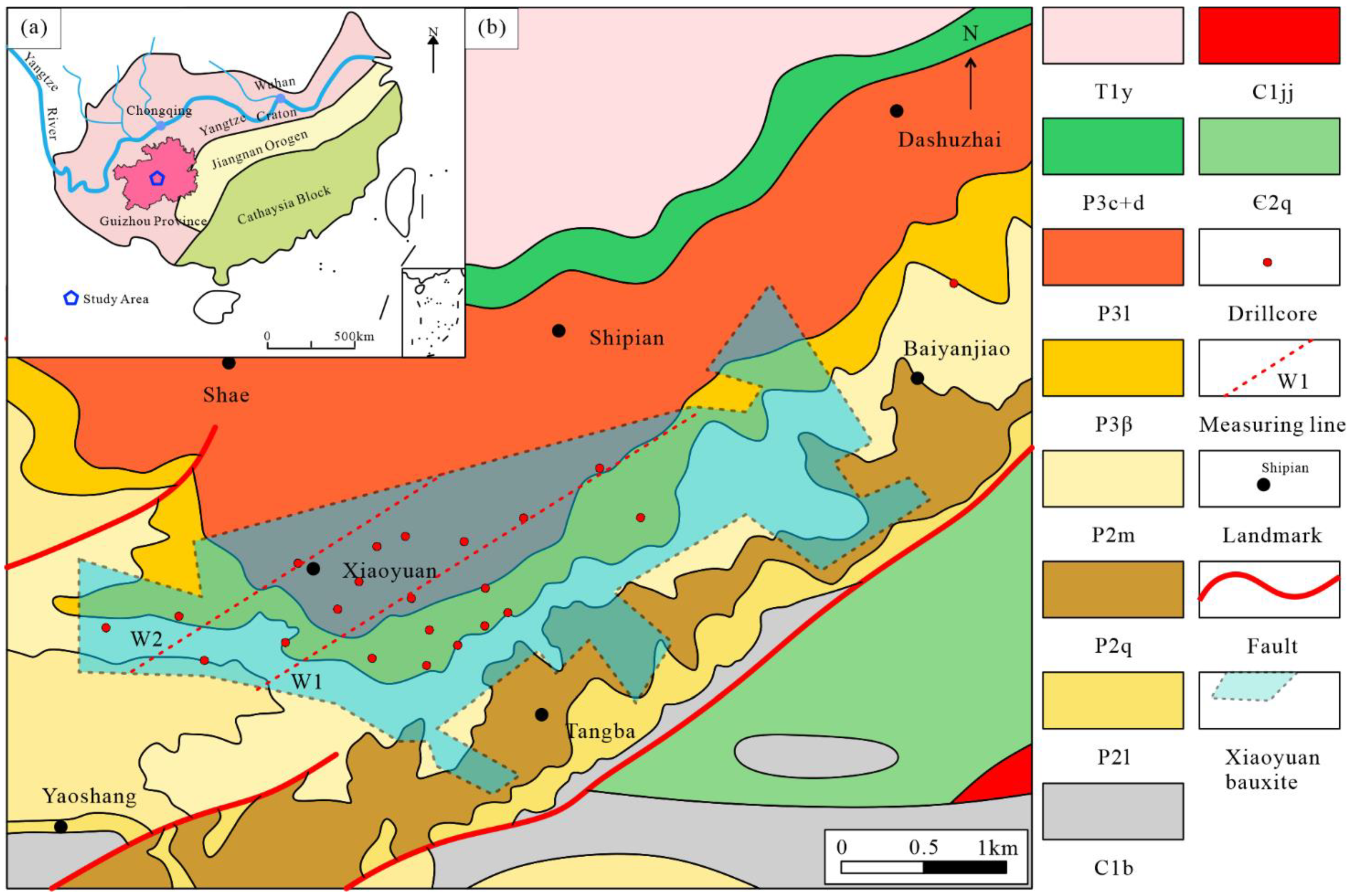

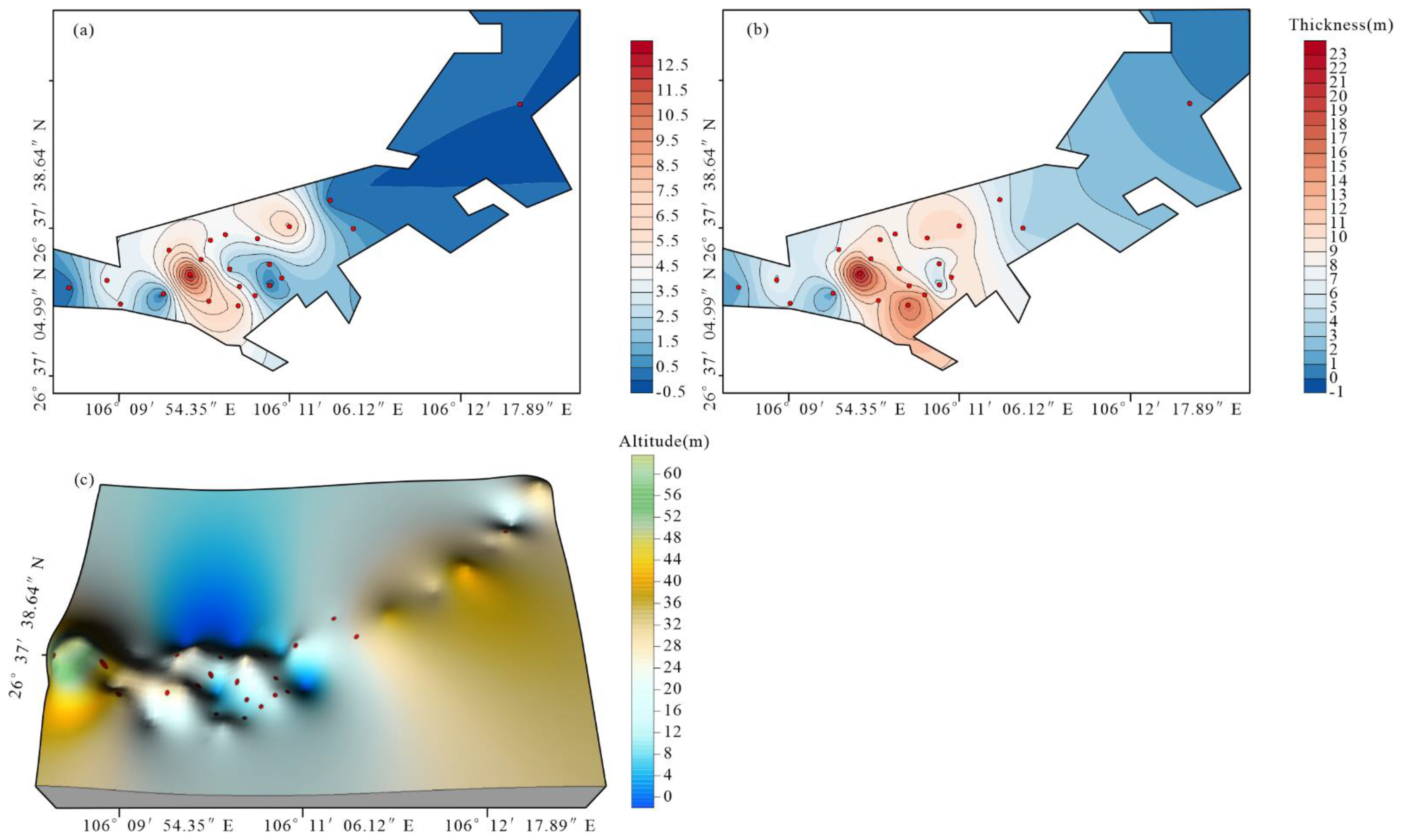

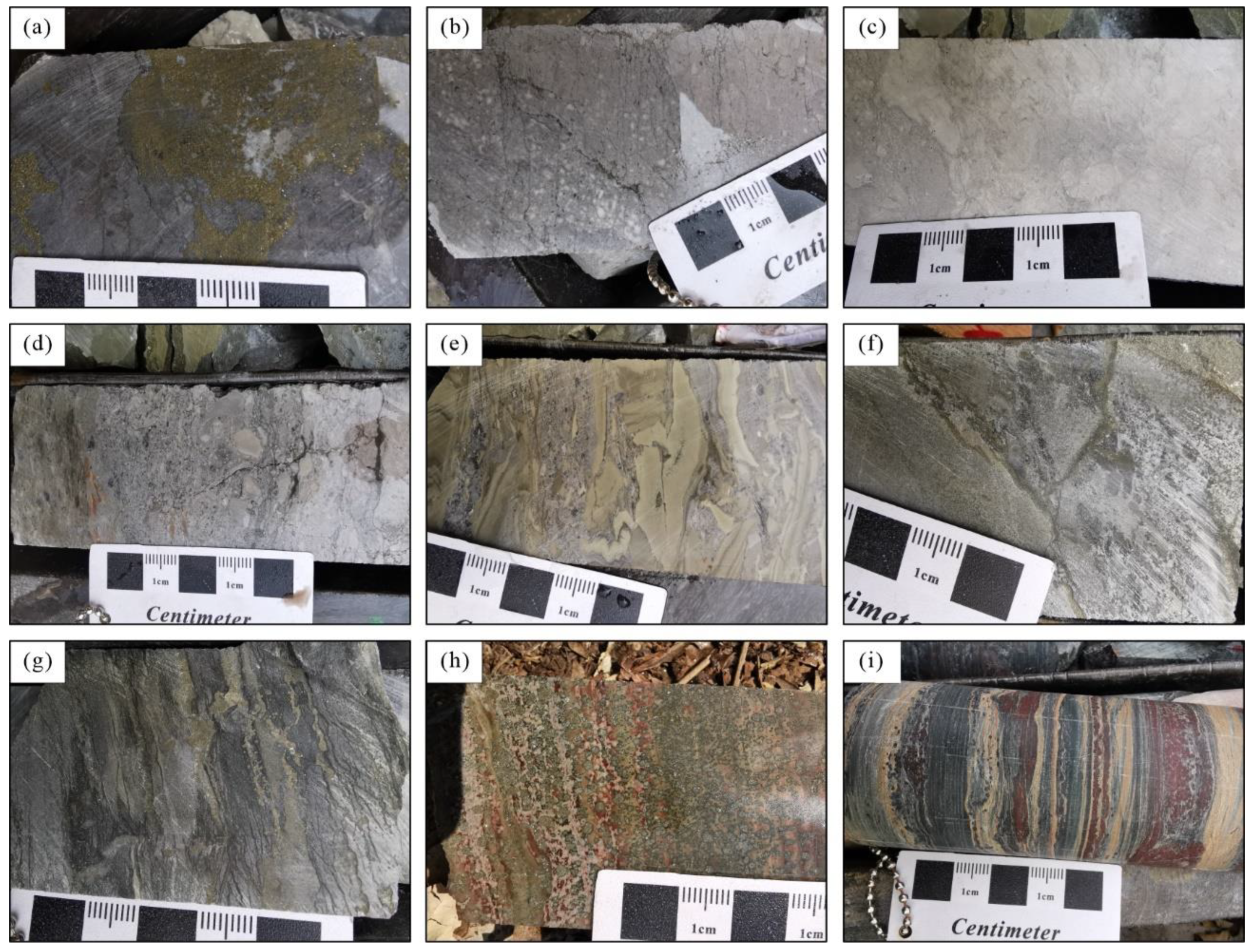

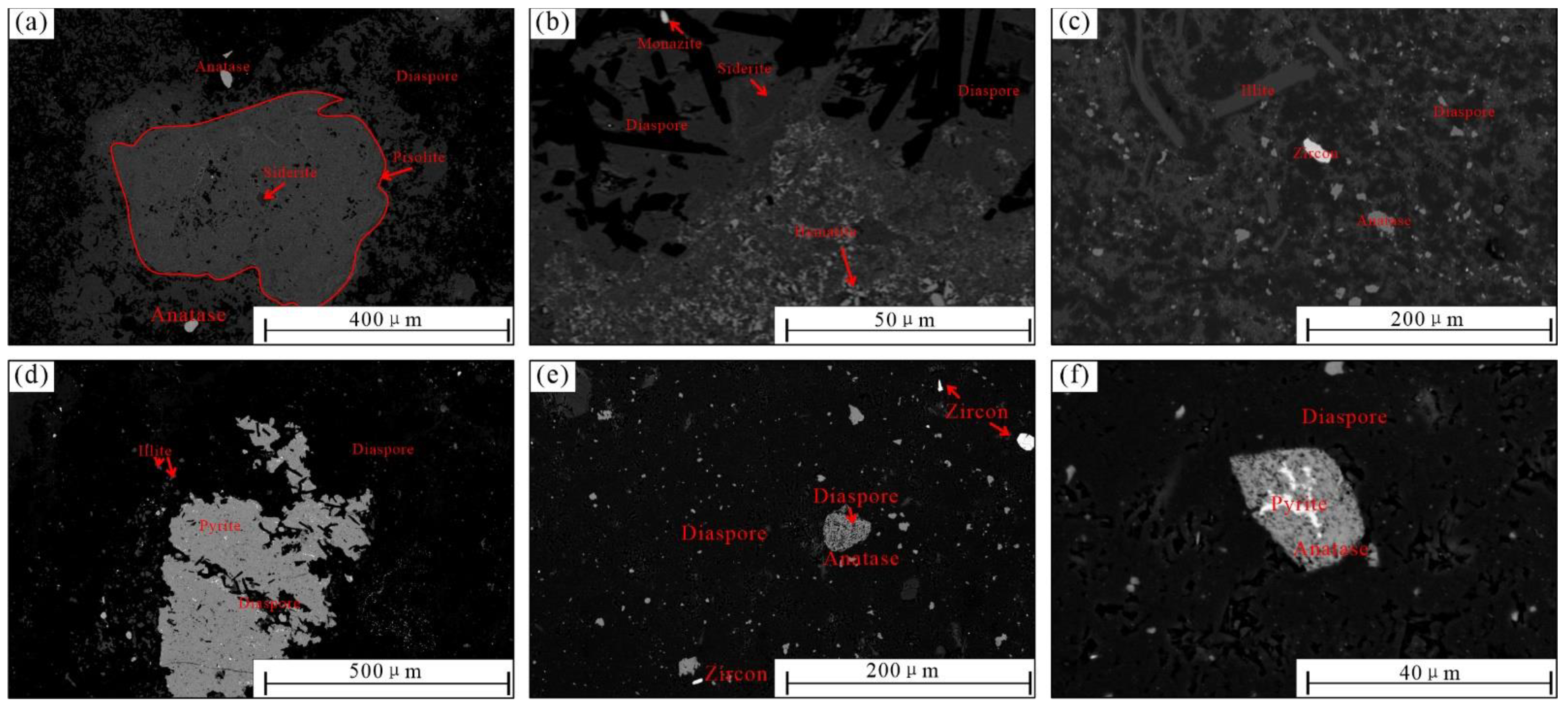

Disclaimer/Publisher’s Note: The statements, opinions and data contained in all publications are solely those of the individual author(s) and contributor(s) and not of MDPI and/or the editor(s). MDPI and/or the editor(s) disclaim responsibility for any injury to people or property resulting from any ideas, methods, instructions or products referred to in the content. |
© 2023 by the authors. Licensee MDPI, Basel, Switzerland. This article is an open access article distributed under the terms and conditions of the Creative Commons Attribution (CC BY) license (https://creativecommons.org/licenses/by/4.0/).
Share and Cite
Mo, H.; Yang, R.; Luo, C.; Li, X.; Ji, Y.; Yang, G.; Zhou, X.; Gao, C.; Hu, X.; Zeng, Z. Effect of Karst Geomorphology on the Sedimentary Mineralization and Geochemical Distribution of Bauxite: An Example from the Xiaoyuan Area in Qingzhen, Guizhou Province. Minerals 2023, 13, 1013. https://doi.org/10.3390/min13081013
Mo H, Yang R, Luo C, Li X, Ji Y, Yang G, Zhou X, Gao C, Hu X, Zeng Z. Effect of Karst Geomorphology on the Sedimentary Mineralization and Geochemical Distribution of Bauxite: An Example from the Xiaoyuan Area in Qingzhen, Guizhou Province. Minerals. 2023; 13(8):1013. https://doi.org/10.3390/min13081013
Chicago/Turabian StyleMo, Hongcheng, Ruidong Yang, Chaokun Luo, Xinzheng Li, Yanbing Ji, Guiyuan Yang, Xumei Zhou, Chuanqian Gao, Xu Hu, and Zhimeng Zeng. 2023. "Effect of Karst Geomorphology on the Sedimentary Mineralization and Geochemical Distribution of Bauxite: An Example from the Xiaoyuan Area in Qingzhen, Guizhou Province" Minerals 13, no. 8: 1013. https://doi.org/10.3390/min13081013




